If you are looking for a space in which to relax contemplating nature, it may be time to build a small Japanese-style garden in which you can spend your free time simply in contact with nature. If you were looking for Zen garden ideas to start this project, look no further, and read this guide.
A Zen garden is a small natural space that, unlike traditional gardens, is made up of rocks and sand. Thanks to the texture of the sand or gravel used to decorate the floor, patterns can be drawn using something similar to a broom.
Rocks, moss, and tree bark replace most of the natural elements of traditional gardens.
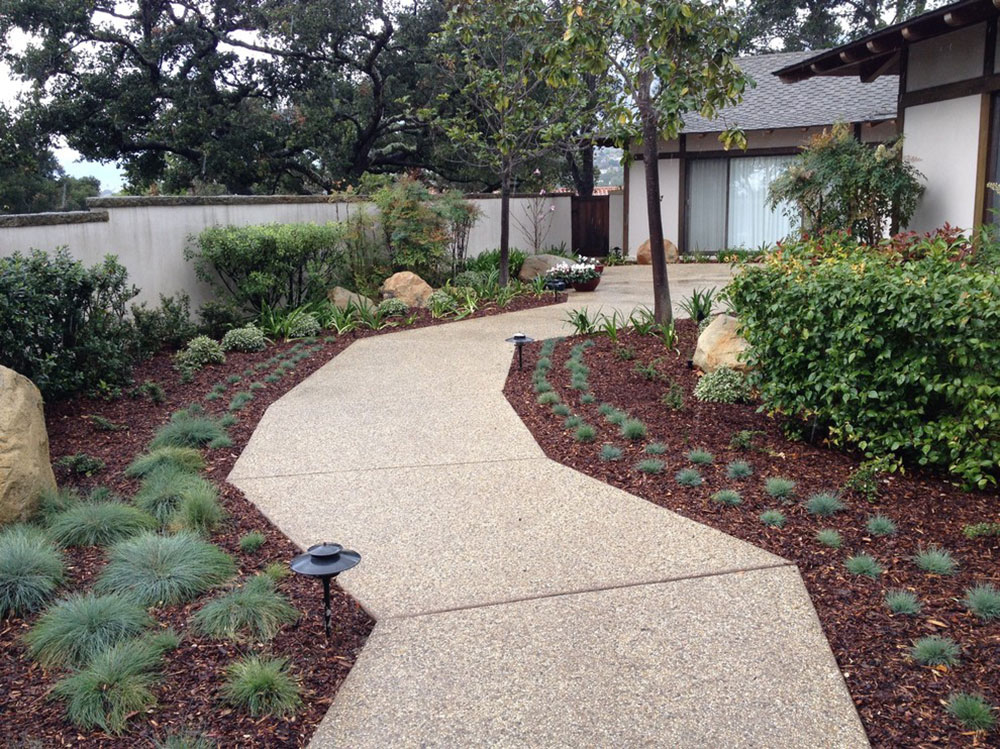
Image source: Charles McClure – Professional Site Planning
Perhaps the best thing about having a small Zen garden is that it does not require much maintenance due to the non-existent vegetation it has, so you can dedicate yourself to enjoying it with each visit. In modern homes, having a Zen garden has become a way to get away from everyday stress.
If you are looking for a new decoration for your home with which you can impress your visitors at any time of the year, a Zen landscape is ideal.
With the following list of tips, you can easily create the panorama you want while maintaining the ultimate goal of inner peace.
Meet the Zen garden
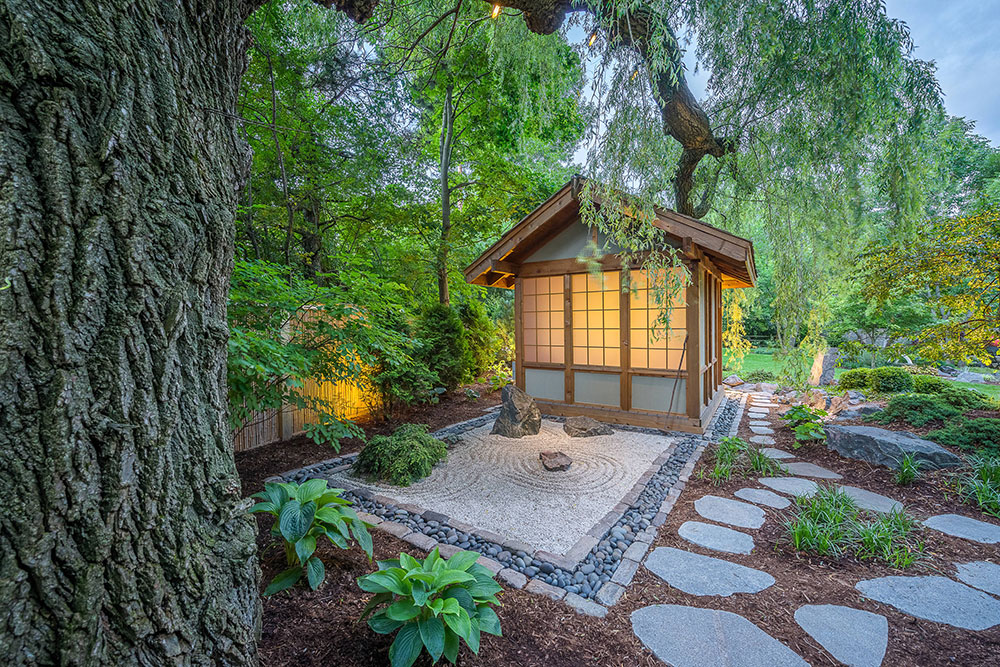 Image source: LandCrafters, Inc
Image source: LandCrafters, Inc
Although we have already presented the benefits of a Zen garden, knowing some theories about them will help you to better understand why they are like this.
- The concept of the Zen garden was born from Buddhism. The search for inner peace led practitioners of Buddhism to create spaces where they could meditate.
- A Zen garden should be simple (Kanso), austere (Koko), and natural (ShiZen), three principles described in Buddhism.
- Additionally, Zen gardens are a mixture of the five fundamental elements, which are wood, earth, fire, water, and metal. These are related to the actions of generating and overcoming, which are also related to each other.
- As we mentioned previously, in a Zen garden, the elements such as water are mostly unnecessary, since sandstone, gravel, and rocks replace these. This is done to create a kind of artificial coastal panorama, in which the ocean waves can be drawn on the sand.
The meaning of raked sand
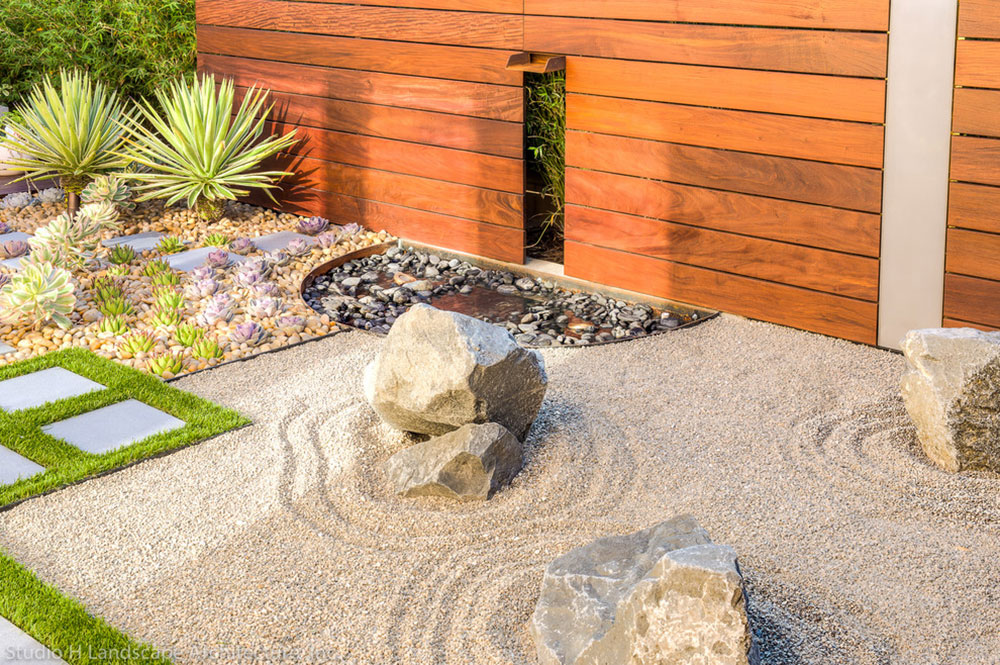 Image source: Studio H Landscape Architecture
Image source: Studio H Landscape Architecture
If you have ever tried to build a sandcastle, you will know that it is very difficult to do if it with dry sand. The same concept applies to the sand in Zen gardens: drawing on it is considered an art that requires a lot of patience because the rocks do not remain uniform.
This was originally used by Buddhists to help them focus, and the practice was kept in modern Zen gardens.
How to build a Zen landscape
Remove unnecessary items
You can start by applying the Zen garden ideas by removing those plant elements that are unnecessary in the environment. Plants that do not fulfill a purpose or that simply overload the environment can be replaced by other arid elements.
Replace vegetation with stone statues or outdoor lamps. With wood pieces, you can create ornamental decorative elements, such as small bridges or paths.
You can keep smaller shrubs, but it is recommended that you prune them in a Japanese style to suit the small Zen garden.
A striking entry
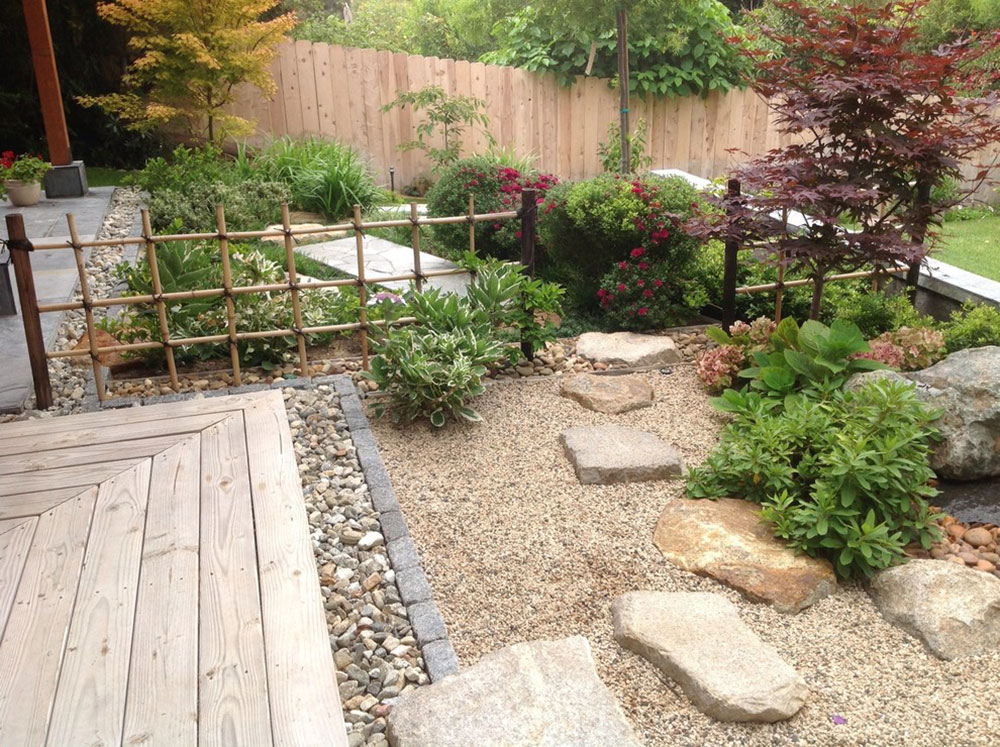 Image source: Modern Zen Garden
Image source: Modern Zen Garden
The Japanese backyard must be an escape from the outside world, so it must lock the perimeter so that you cannot see outside. To preserve the style, you can use a bamboo fence.
As for the entrance, it must be kept simple but striking enough to be recognized. A gazebo can function as a capturing element, and if you decorate it with vines on the columns, it will maintain its natural appearance.
Designs using rocks
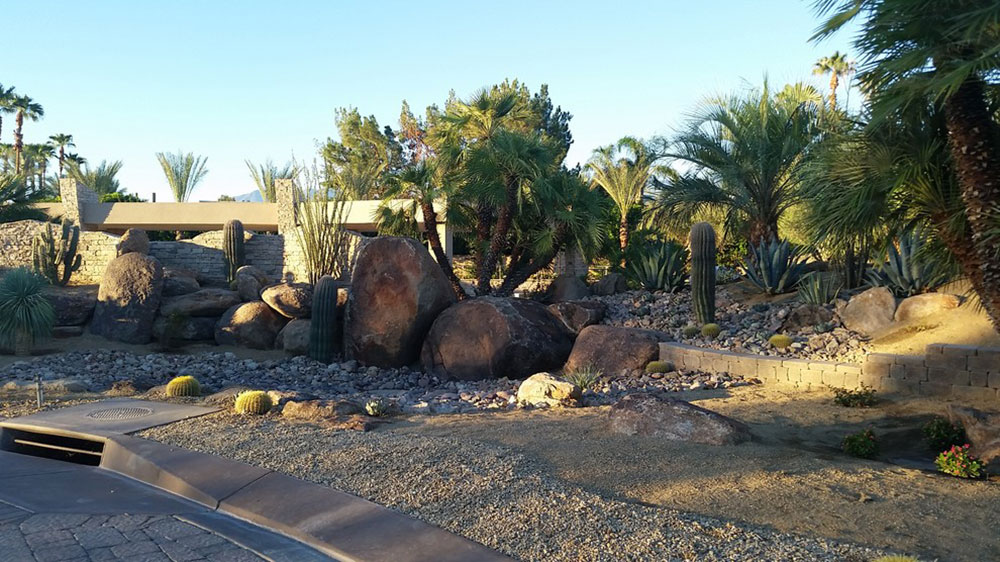 Image source: Logan Landscape Inc
Image source: Logan Landscape Inc
There are many Zen garden ideas that you can apply simply using rocks. These are a basic component of these gardens, so you will be using them constantly.
The size and location of the rock are important; these will determine if it is symbolized a desert island in the ocean or if it is a mountain.
Due to the physical characteristics and the way they are located, rocks can also symbolize one of the five natural elements that we mentioned previously.
- Reisho Rocks (Metal): they are small rocks that look solid and firm in their context as if they were immovable.
- Shintai Rocks (Water): are flat and low rocks, similar to those found on the bottom of the rivers. They represent the water’s fluidity
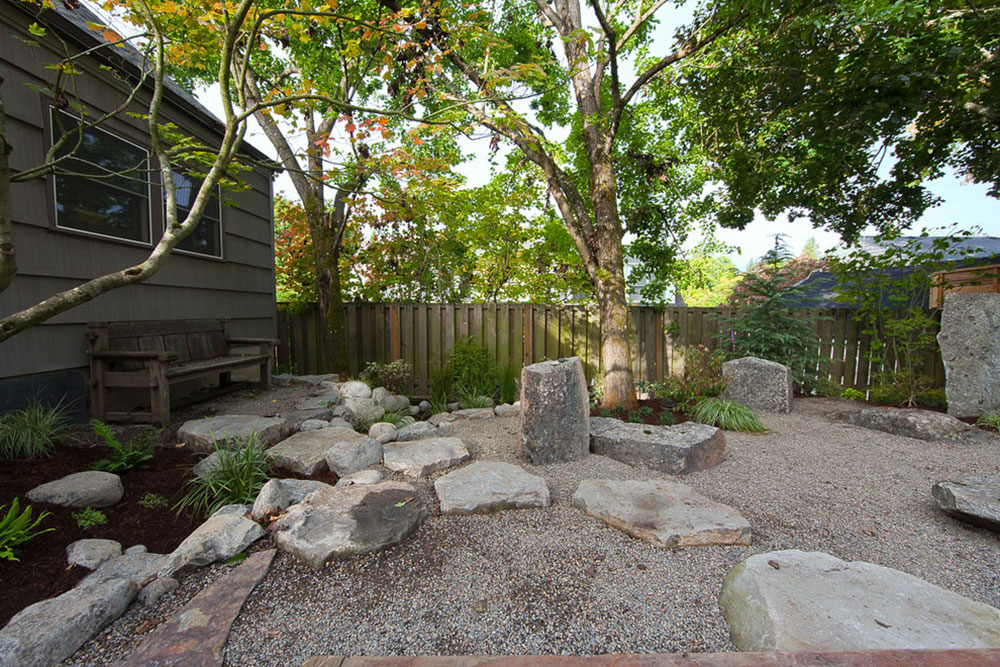 Image source: Plan-it Earth Design
Image source: Plan-it Earth Design
- Kikyaku Rocks (Earth): rocks supported on one of their sides represent the earth.
- Taido Rocks (Wood): they are large rocks that represent trees. Zen garden design will generally include them next to the Reisho rocks to create a contrast between the two.
- Shigyo Rocks (Fire): made up of irregular rocks, they represent the wild and restless pattern of fire.
Use what you have available
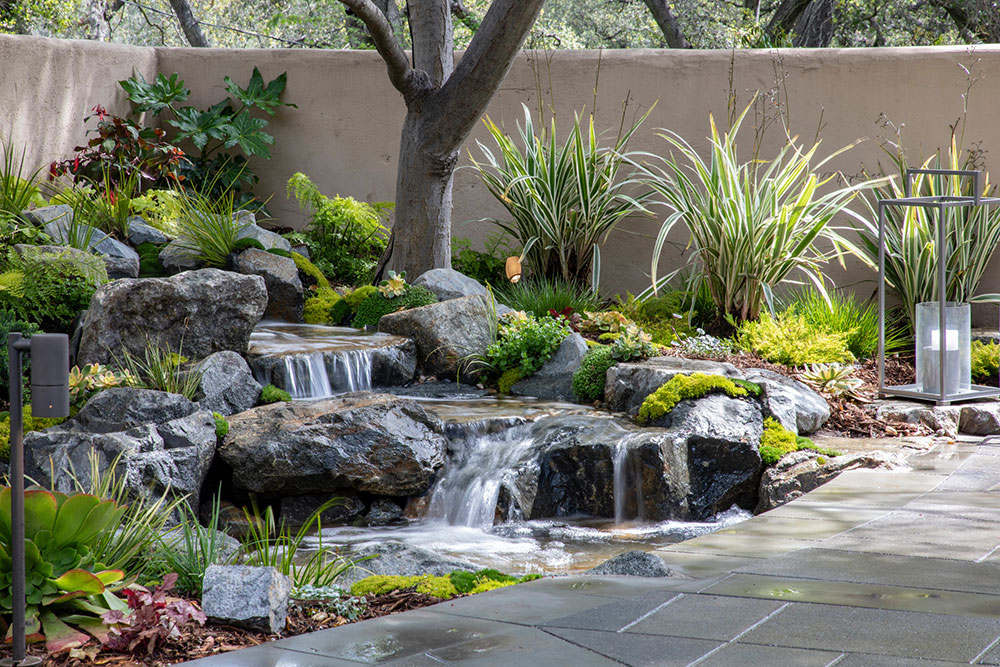 Image source: California Waterscapes
Image source: California Waterscapes
It is always better to start with a base. If you already have a garden and want to change the style, remodeling could be much easier.
The only case in which remodeling will be more tortuous is if your garden has a lot of mature plants, which will be difficult to remove.
If you have a water source, don’t remove it entirely. It is best to try to channel it to create a small stream that empties into a pond.
Moss is an ally
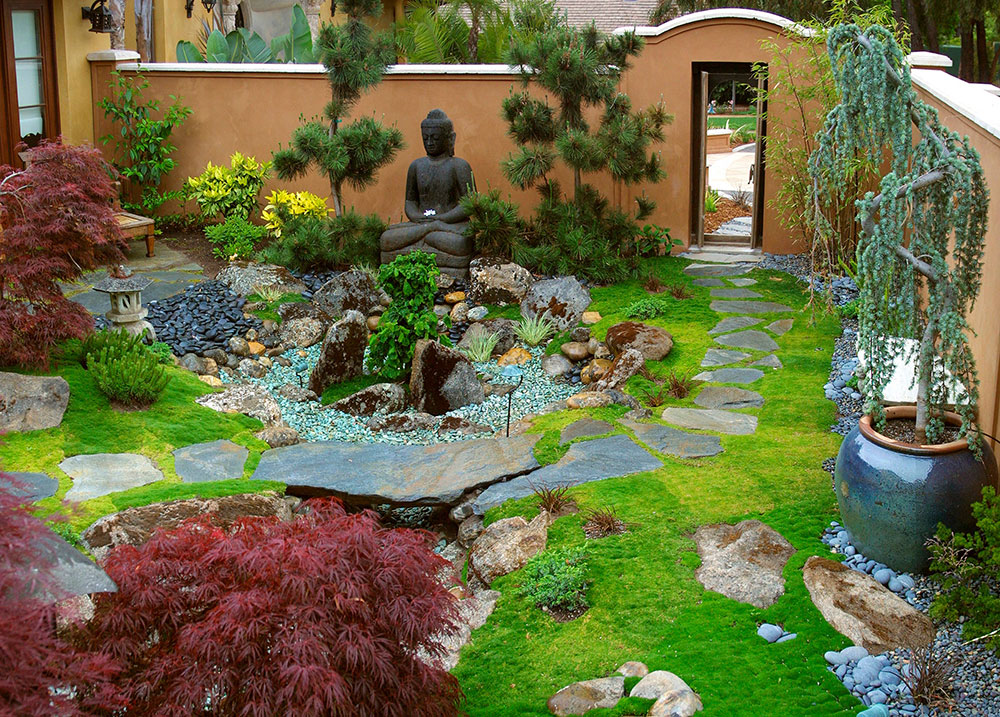 Image source: Margie Grace – Grace Design Associates
Image source: Margie Grace – Grace Design Associates
Moss should grow naturally in cold, wet spaces in your yard. Don’t remove it and let it grow on some rocks for a natural look. There are many Zen garden ideas you can do with moldy rocks, like creating a path that intersperses stones with and without moss.
For your safety, and to preserve the moss, try not to step on it, as it is slippery and can damage its padded texture.
You can’t miss the pagodas
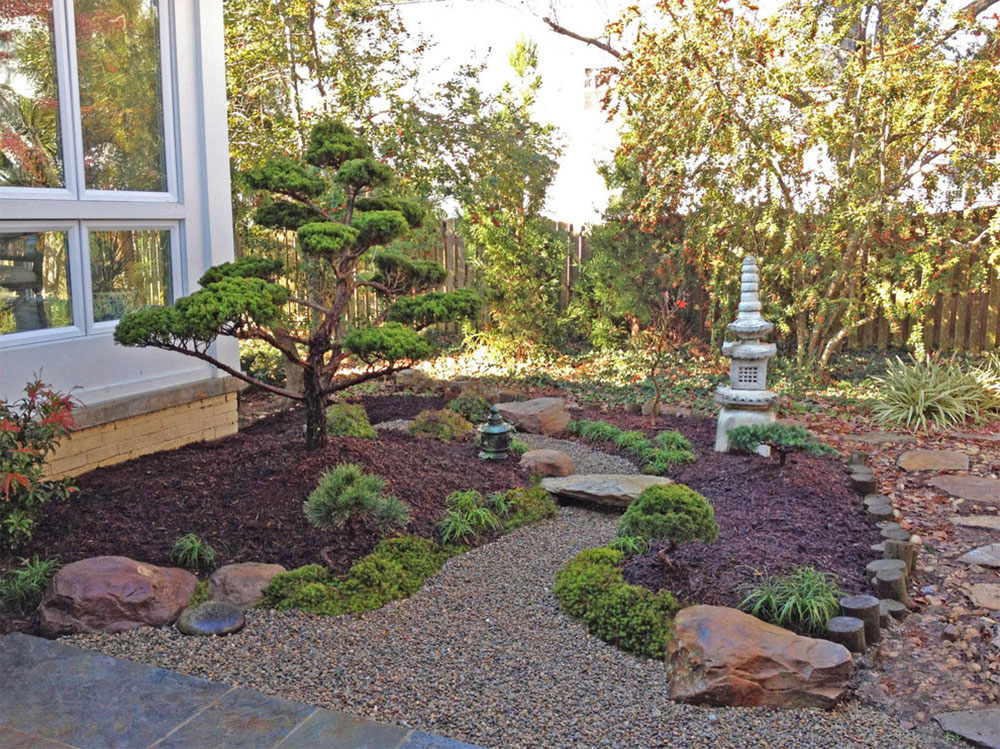 Image source: Lee’s Oriental Landscape Art
Image source: Lee’s Oriental Landscape Art
A Zen garden cannot be complete without a pagoda to decorate it, or at least a pagoda-shaped stone lamp. These Asian structures have a characteristic design that adapts to any type of decoration. Although the most common is to find them as floor lamps, it is also possible to buy designs for ceilings.
Water mirrors
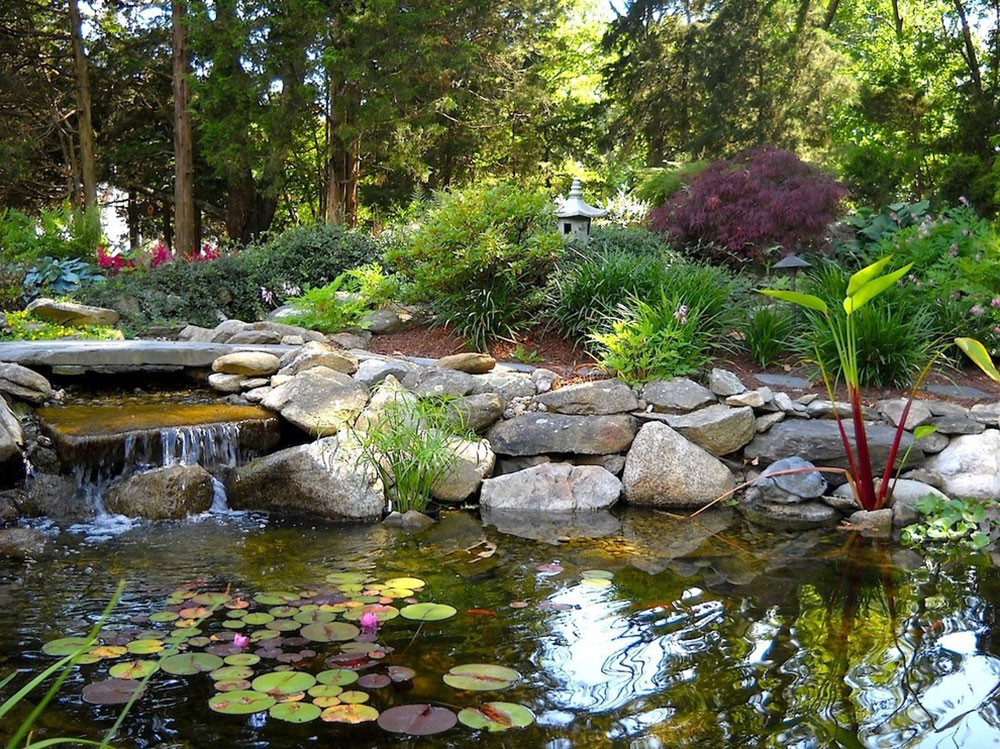 Image source: Avalon Design Group
Image source: Avalon Design Group
You can make your outdoor Zen garden look more spacious with the use of water mirrors. These are ponds where the water remains static, creating a natural mirror that will reflect the sky. Some decorators include Koi fishes inside the pond, but remember to take care of them.
A space to rest
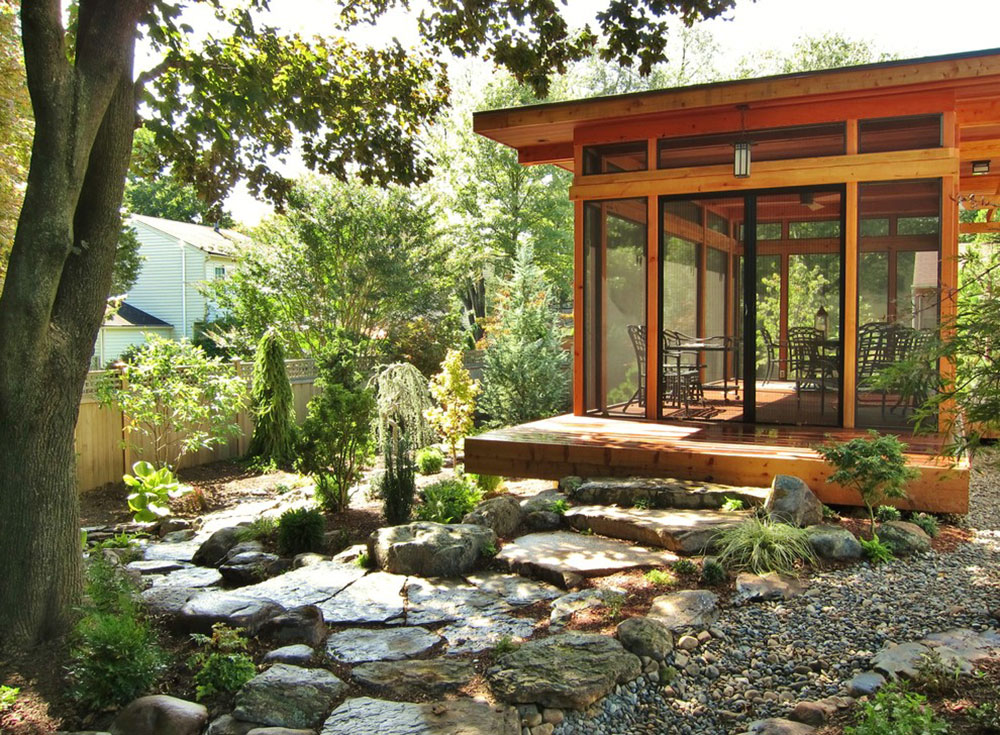 Image source: The Art of Landscape
Image source: The Art of Landscape
If you did not place the gazebo at the entrance, you can always build a larger pavilion where you can rest. Use wood or bamboo on the frame to preserve the style.
Spectacular examples of Zen gardens
Kogetsudai – Great gravel mountains
One way to represent mountains in a Zen garden is by stacking gravel to create cones with flat tops. They don’t have to be as big as the one in this Ginkaku-ji Temple image, which tries to imitate the mythical Mount Fuji. A small cluster is enough.
Ryoan-ji – The most famous garden of all
Many Zen garden ideas can be obtained from the Temple of the Dragon at Peace, and that is that it perfectly combines nature’s serenity in an arid environment. The enclosure has 248 square meters of white gravel, and 15 large stones decorate the panorama.
Anyo-in Taisan-ji – Rocky landscape
A Zen garden can also do without gravel, as shown in this Japanese garden. The designer intended to represent large mountain ranges that follow the flow of a river.
Isamu Noguchi Garden Museum – To work in peace
This studio located in Kagawa, Japan, mixes a set of irregular stones with other totally polished ones to create a landscape that shows dedication to work.
Taizo-in / Myoshin-ji – A work of art
Although dating from the 15th century, this Buddhist temple stands out nowadays for its two beautiful natural gardens and its traditional Zen garden.
Japanese Garden of Contemplation – A melancholic atmosphere
The combination of the vegetation around the pond creates a traditional environment whose purpose is to reassure the spectators.
Saiho-ji – Magical aura
It is obvious to see why it is called “The Moss Temple”. The original design did not include the moss, but it grew due to the deterioration of the temple. In the end, it was decided to keep the result.
Additional tips for creating a Zen landscaping
- If you want to use wood, try to use bamboo. This is perfect for all types of construction, including bridges and fences, as it is very resistant.
- Add intimate spaces within the Zen garden, such as pavilions. If you have a lot of space and plan to install a large pond, you can even build a canopy on the water.
- Use moss to create a contrast between natural and artificial elements.
- The Zen garden has its appeal in the visual part, so most Zen garden ideas focus on you designing it to see it from a single angle. Everything that cannot be seen is unnecessary.
- The best design when raking gravel is that of parallel lines or waves. These create a panorama similar to that of the ocean.
- You cannot forget the fundamental elements of the garden that are the rocks. Adding a pond helps create contrast and a calmer environment.
- Use plants that grow on the sides and not in height.
If you enjoyed reading this article about outdoor zen garden ideas, you should read these as well:
- Outdoor Christmas lights ideas to use when decorating your house
- Amazing cactus garden ideas you could try for your backyard
- Garden fence ideas that are practical and look great too
The post Use these Zen garden ideas to create a relaxing outdoor space appeared first on Impressive Interior Design.
source https://www.impressiveinteriordesign.com/zen-garden-ideas/
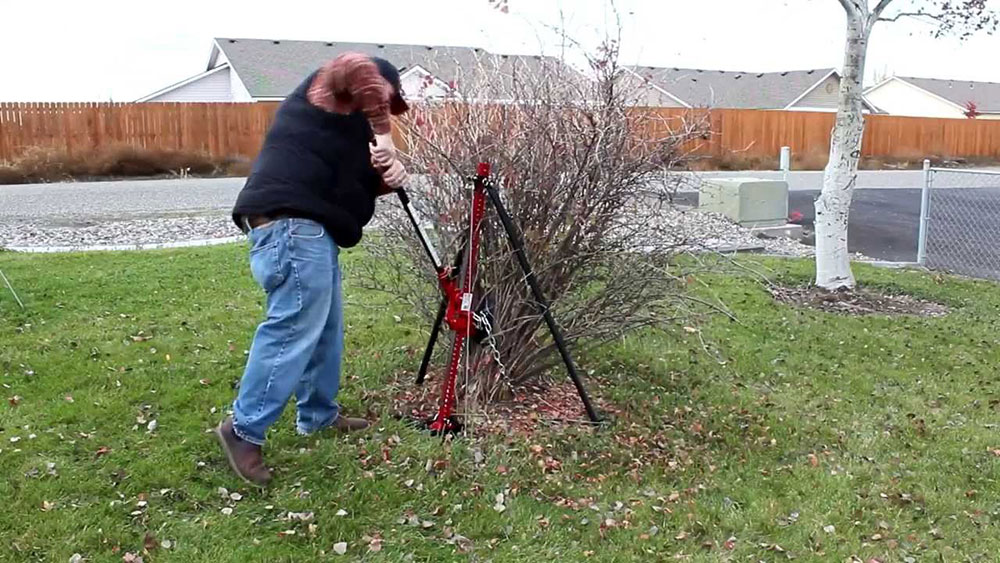
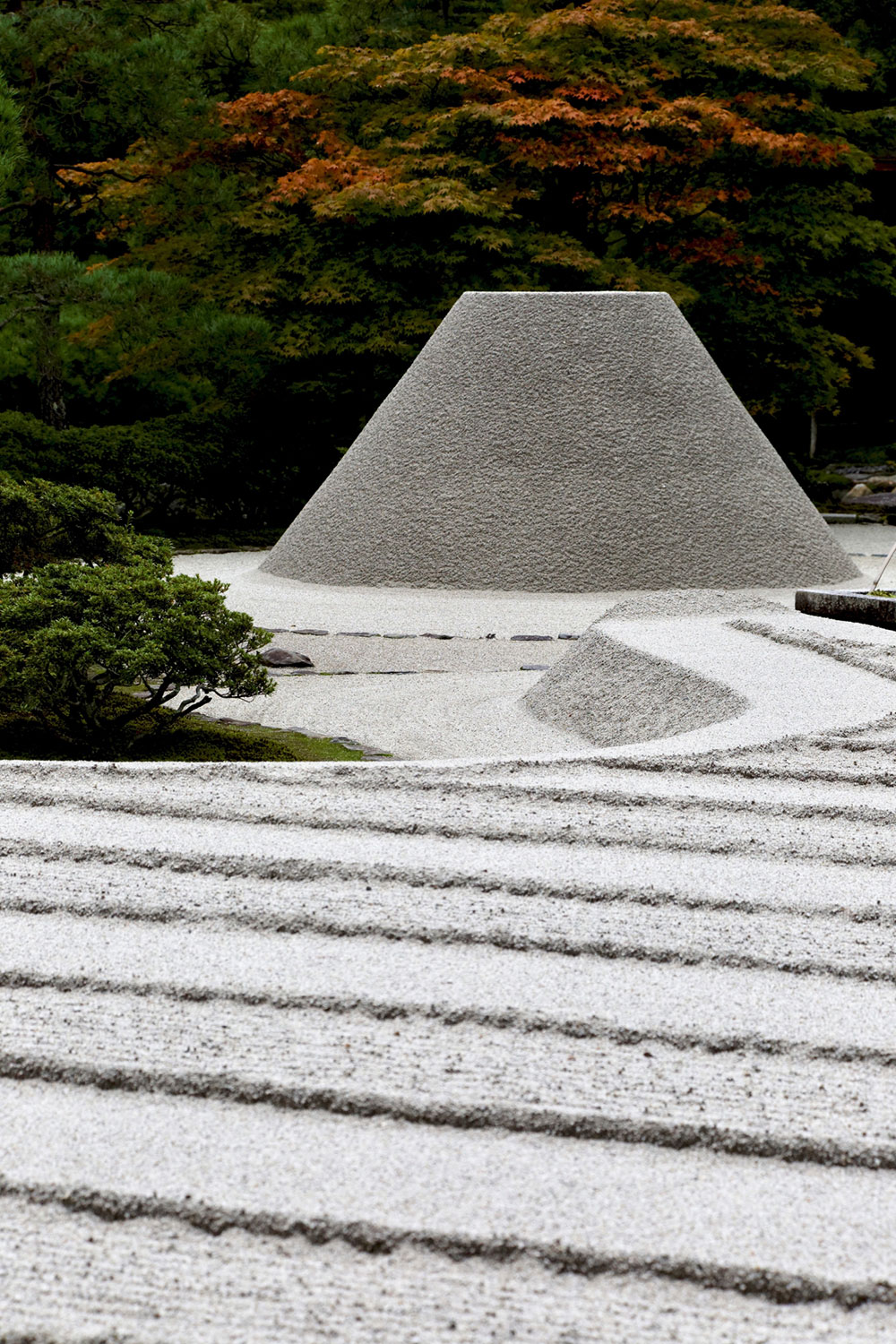
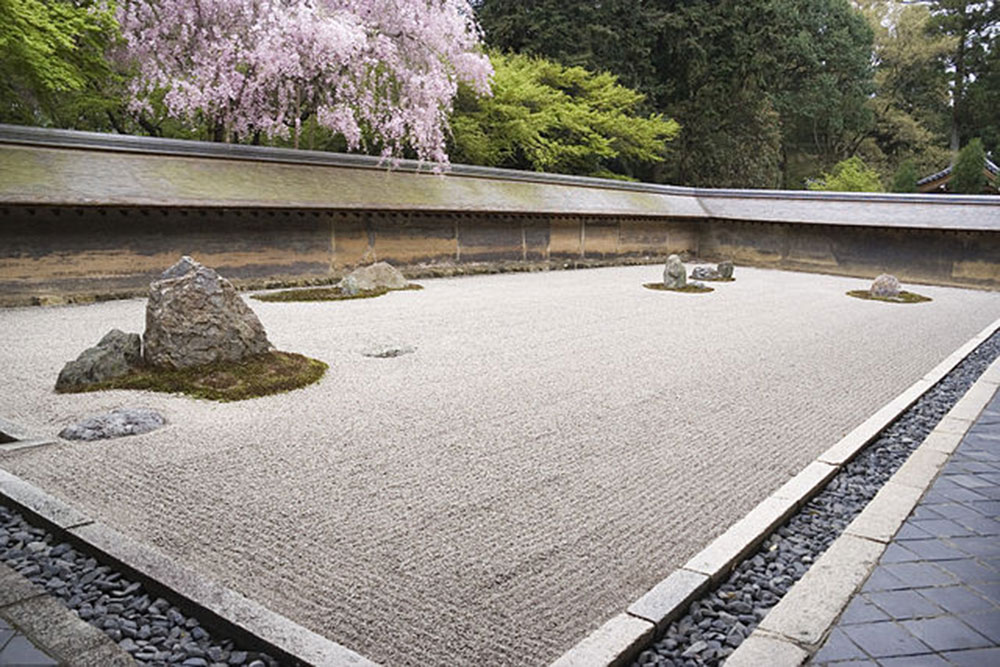
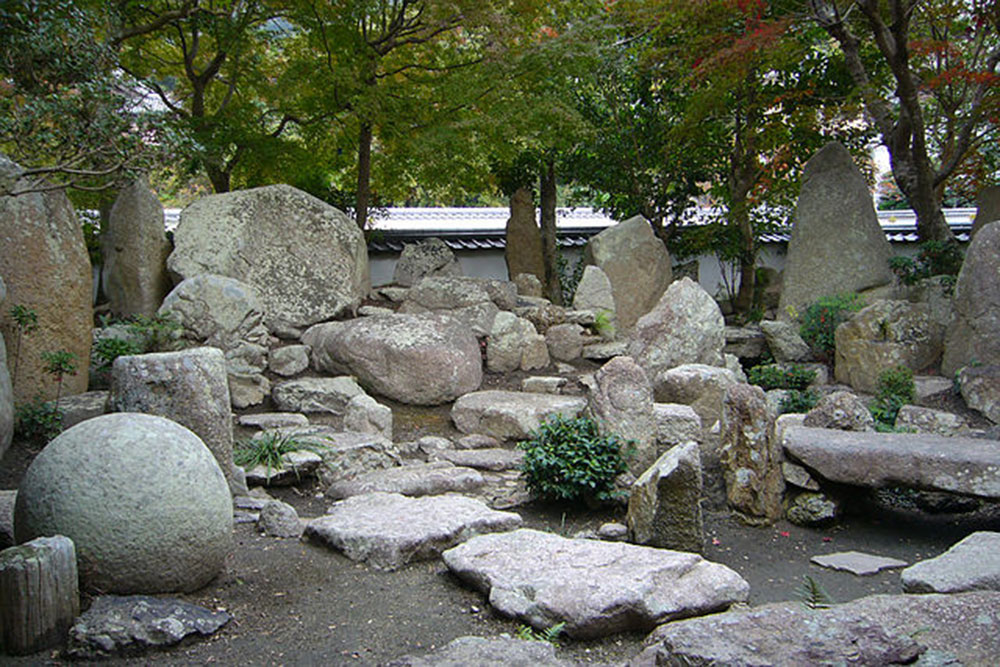
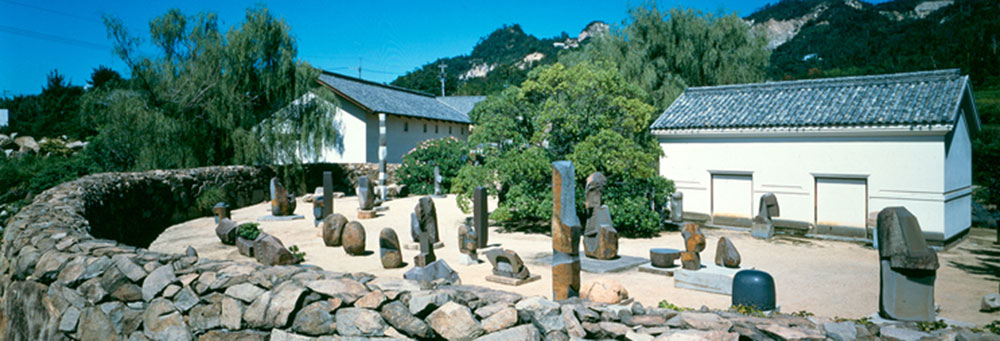
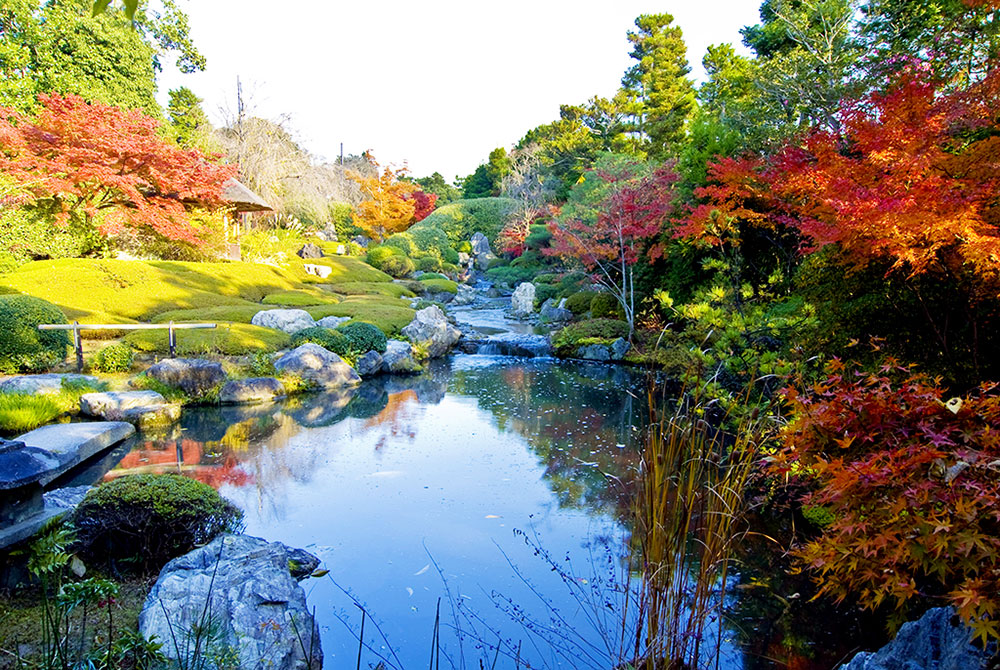
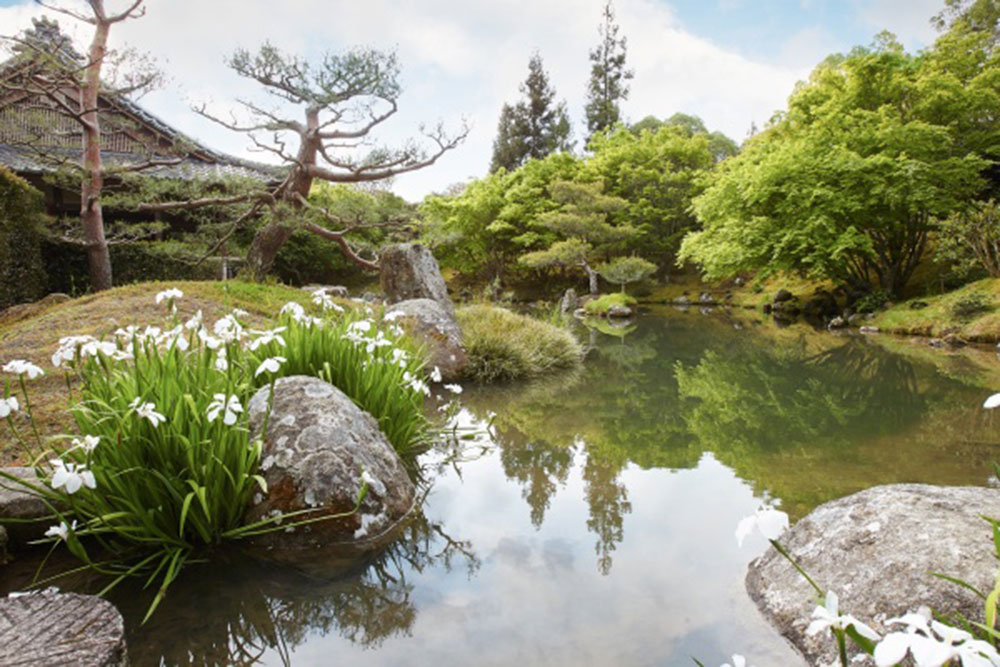
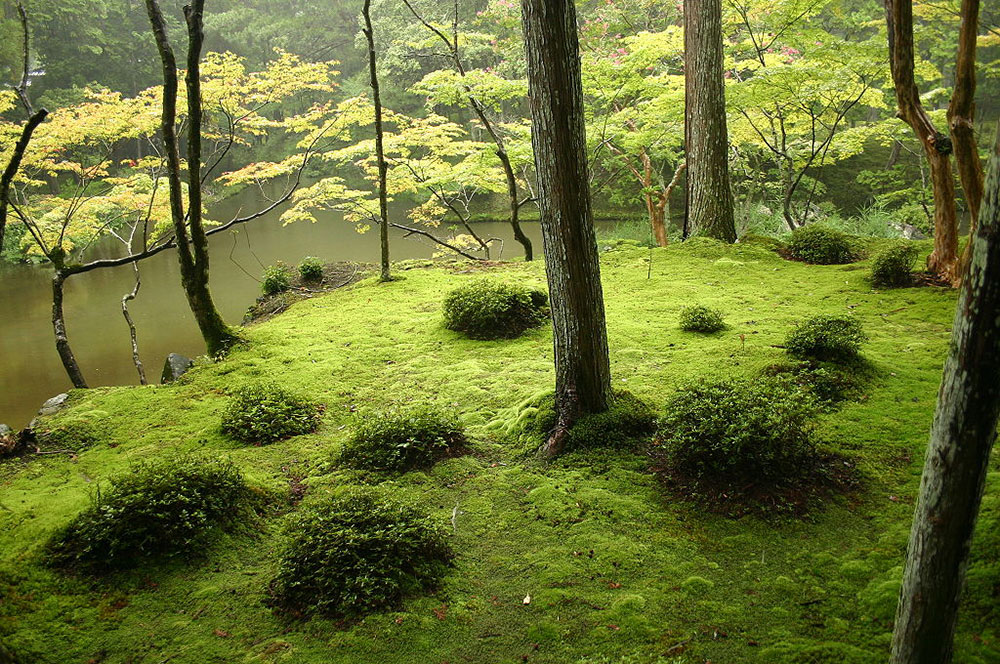
No comments:
Post a Comment